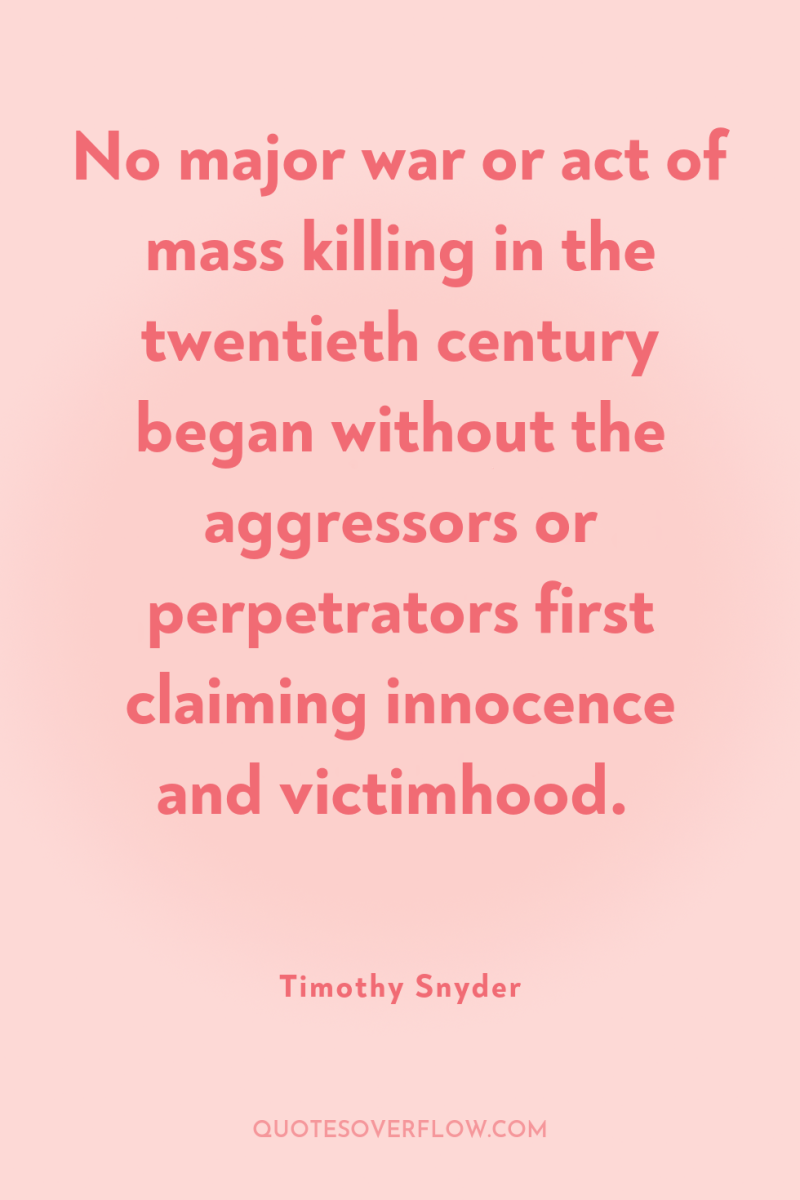
1
No major war or act of mass killing in the twentieth century began without the aggressors or perpetrators first claiming innocence and victimhood.Timothy Snyder
2
The American and British soldiers who liberated the dying inmates from camps in Germany believed that they had discovered the horrors of Nazism. The images their photographers and cameramen captured of the corpses and the living skeletons at Bergen-Belsen and Buchenwald seemed to convey the worst crimes of Hitler..this was far from the truth. The worst was in the ruins of Warsaw, or the fields of Treblinka, or the marshes of Belarus, or the pits of Babi Yar.Timothy Snyder
3
The vast majority of Jews killed in the Holocaust never saw a concentration camp.Timothy Snyder
4
It is less appealing, but morally more urgent, to understand the actions of the perpetrators. The moral danger, after all, is never that one might become a victim but that one might be a perpetrator or a bystander. It is tempting to say that a Nazi murderer is beyond the pale of understanding..Yet to deny a human being his human character is to render ethics impossible. To yield to this temptation, to find other people inhuman, is to take a step toward, not away from, the Nazi position. To find other people incomprehensible is to abandon the search for understanding, and thus to abandon history.Timothy Snyder
5
...But this number, like all the others, must be seen not as 5.7 million, which is an abstraction few of us can grasp, but as 5.7 million times one. This does not mean some generic image of a Jew passing through some abstract notion of death 5.7 million times. It means countless individuals who nevertheless have to be counted, in the middle of life...Timothy Snyder
6
How could a large land empire thrive and dominate in the modern world without reliable access to world markets and without much recourse to naval power? Stalin and Hitler had arrived at the same basic answer to this fundamental question. The state must be large in territory and self-sufficient in economics, with a balance between industry and agriculture that supported a hardily conformist and ideologically motivated citizenry capable of fulfilling historical prophecies - either Stalinist internal industrialization or Nazi colonial agrarianism. Both Hitler and Stalin aimed at imperial autarky, within a large land empire well supplies in food, raw materials, and mineral resources. Both understood the flash appeal of modern materials: Stalin had named himself after steel, and Hitler paid special attention to is production. Yet both Stalin and Hitler understood agriculture as a key element in the completion of their revolutions. Both believed that their systems would prove their superiority to decadent capitalism, and guarantee independence from the rest of the world, by the production of food.p. 158.Timothy Snyder
7
Now we will live! ” This is what the hungry little boy liked to say, as he toddled along the quiet roadside, or through the empty fields. But the food that he saw was only in his imagination. The wheat had all been taken away, in a heartless campaign of requisitions that began Europe’s era of mass killing. It was 1933, and Joseph Stalin was deliberately starving Soviet Ukraine. The little boy died, as did more than three million other people. “I will meet her, ” said a young Soviet man of his wife, “under the ground.” He was right; he was shot after she was, and they were buried among the seven hundred thousand victims of Stalin’s Great Terror of 1937 and 1938. “They asked for my wedding ring, which I….” The Polish officer broke off his diary just before he was executed by the Soviet secret police in 1940. He was one of about two hundred thousand Polish citizens shot by the Soviets or the Germans at the beginning of the Second World War, while Nazi Germany and the Soviet Union jointly occupied his country. Late in 1941, an eleven-year-old Russian girl in Leningrad finished her own humble diary: “Only Tania is left.” Adolf Hitler had betrayed Stalin, her city was under siege by the Germans, and her family were among the four million Soviet citizens the Germans starved to death. The following summer, a twelve-year-old Jewish girl in Belarus wrote a last letter to her father: “I am saying good-bye to you before I die. I am so afraid of this death because they throw small children into the mass graves alive.” She was among the more than five million Jews gassed or shot by the Germans.Timothy Snyder
8
Stalin had developed an interesting new theory: that resistance to socialism increases as its successes mount, because its foes resist with greater desperation as they contemplate their final defeat. Thus any problem in the Soviet Union could be defined as an example of enemy action, and enemy action could be defined as evidence of progress. P. 41Timothy Snyder